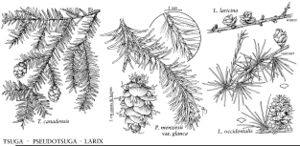Larix laricina
Dendrologie 2(2): 263. 1873.
Trees to 20m; trunk to 0.6m diam.; crown narrow, branches sparse. Bark of young trees gray, smooth, becoming reddish brown and scaly, inner layer red-purple. Branches horizontal or slightly ascending; twigs orange-brown, glabrous. Buds dark red, subtended by ring of hairlike bracts, glabrous. Leaves of short shoots 1–2cm × 0.5–0.8mm, 0.3–0.5mm thick, keeled abaxially, rounded adaxially, pale blue-green; resin canals 10–20µm from margins. Seed cones 1–2 × 0.5–1cm, usually on curved stalks 2–5 × 2–2.5mm, sometimes sessile on long shoots; scales 10–30, margins entire, brown-strigose to -tomentose at base; bracts mucronate or tipped by awn to 1mm, hidden by mature scales, at first dark red to violet, later turning yellow-brown. Pollen 53–65µm diam. Seeds with bodies 2–3mm, wings 4–6mm. 2n =24.
Habitat: Boreal forests in wet, poorly drained sphagnum bogs and muskegs, also on moist upland mineral soils
Elevation: 0–1200m
Distribution

St. Pierre and Miquelon, Alta., B.C., Man., N.B., Nfld. and Labr., N.W.T., N.S., Nunavut, Ont., P.E.I., Que., Sask., Yukon, Alaska, Conn., Ill., Ind., Maine, Md., Mass., Mich., Minn., N.H., N.J., N.Y., Ohio, Pa., R.I., Vt., W.Va., Wis.
Discussion
Disjunct Alaskan populations of Larix laricina, originally described as Larix alaskensis on the basis of narrower cone scales and bracts, are indistinguishable from other populations of the species.
The wood of tamarack is used for railway ties, pilings, and posts; it formerly was used for boat construction. Slow-growing trees develop wood with high resin content, making it decay resistant but limiting its value for pulpwood. The bark contains a tannin, which has been used for tanning leather. Although tamarack is the most rapidly growing boreal conifer under favorable conditions, it is of little commercial interest because of insect and disease problems and its poor pulping properties. Plants of this species are often stunted in the far north and on mountain slopes.
Selected References
None.
